Family : Chamaeleonidae

Text © Dr. Luca Tringali

English translation by Mario Beltramini
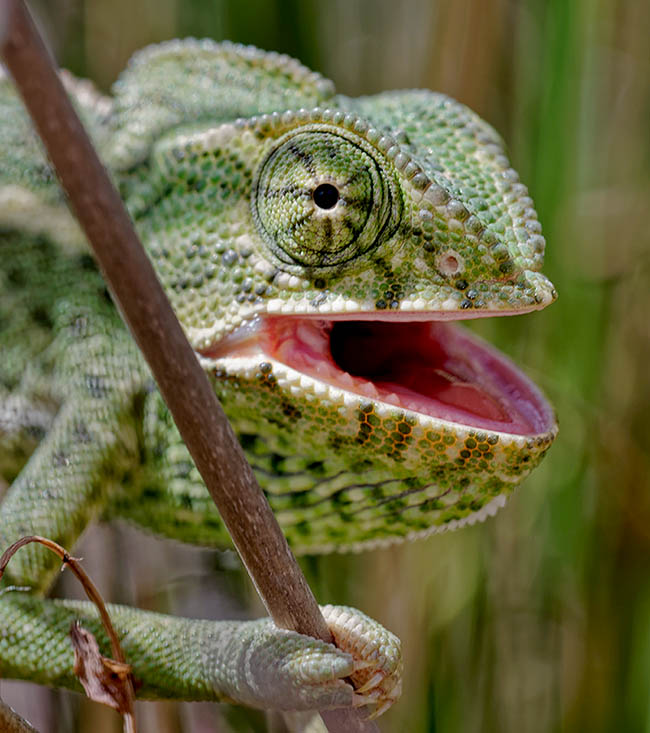
Defined twice leon in the scientific name, Chamaeleo chamaeleon has strong teeth for chewing the preys © Manuel García-Viñó Sánchez
The Common chameleon, also known with the name of European chameleon or Mediterranean chameleon, Chamaeleo chamaeleon (Linnaeus, 1758), is a lizard of family Chamaeleonidae, to which belong about 210 species diffused in Mediterranean Europe, western Asia, Africa and, especially, with the 40% of its total, in Madagascar.
Particularly well adapted to the arboreal environment, the chameleon owes its name to the fusion of the two Greek words “χαμαί” (chamé), below, and “λέων” (léon), lion, to indicate the extreme predator ability of the “crawling lion”.
Recent phylogenetic researches attribute to the genus Chamaeleo at least 12 African and Eurasian species.
It seems that this genus originated in South Africa during the Eocene, 50 million years ago (Mya), whilst the diversification at the species level and the consequent diffusion northwards took place during the Miocene, 20 to 5 Mya.
Some morphological characteristics, along with some physiological and ethological specializations, render the chameleons immediately recognizable: the structure of the helmet-shaped head, the cranial crests, the tail and the prehensile limbs.
Zoogeography
Chamaeleo chamaeleon is a species with East-Mediterranean Saharo-Syndican Palearctic diffusion, whose distribution is the northernmost amongst the members of the family; introduced by man in Cyprus about 9000 years ago, and more recently in Italy, in some Greek islands and in Malta, it is native from Morocco to Saudi Arabia and from Portugal to South-eastern Turkey. Presently, four subspecies are recognized:
Chamaeleo chamaeleon chamaeleon (Linnaeus 1758): the nominal species is surely present in southern Portugal and Spain, western Sahara, Morocco, Algeria, Tunisia, Libya, coastal Egypt;
Chamaeleo chamaeleon musae Steindachner 190: distributed in Israel and desertic Egypt (northern Sinai);
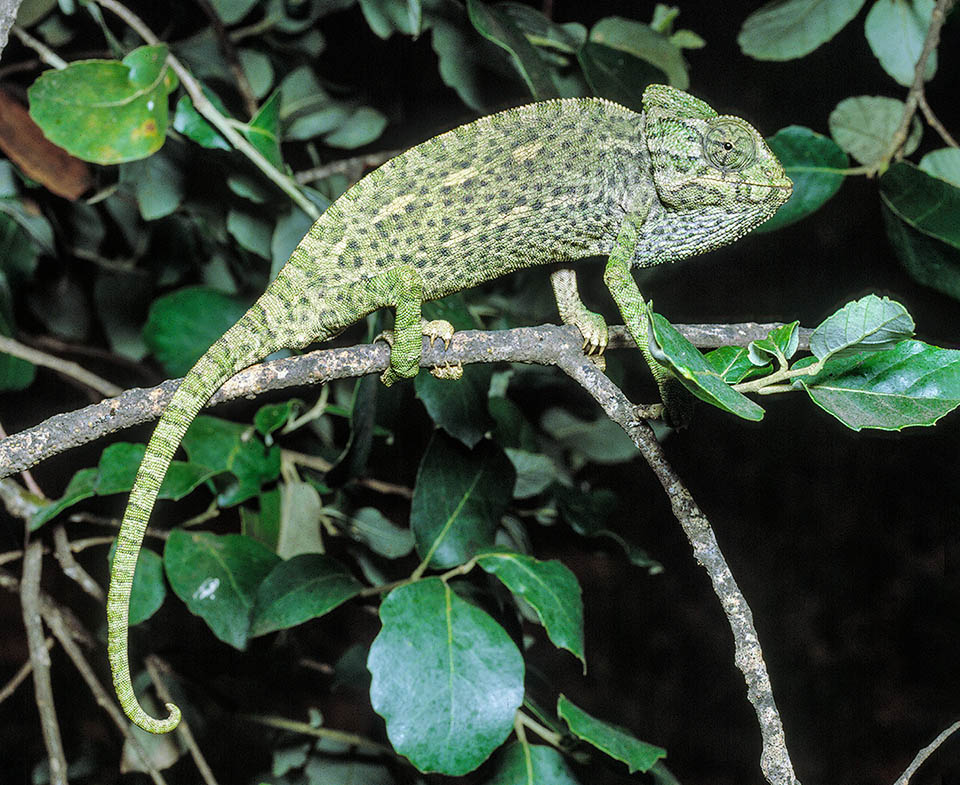
Strictly arboreal, it usually gets a cryptic colour to camouflage with the surrounding environment. Counting also the spread tail it can reach the 30 cm © Giuseppe Mazza
Chamaeleo chamaeleon orientalis Parker 1938: present in Saudi Arabia;
Chamaeleo chamaeleon recticrista Boettger 1880: diffused in Cyprus, South-eastern Turkey, Jordan, Israel Lebanon, Syria.
The phylogenetic variations of Chamaeleo chamaeleon have not yet been adequately investigated, and therefore the subspecific attribution, at least in the sites where it has been recently introduced, insular Greece (Crete, Samos, Chios), Malta, Italy (Calabria and Apulia), has not yet been completely clarified; the Apulian populations, for instance, could belong to three of the four known subspecies.
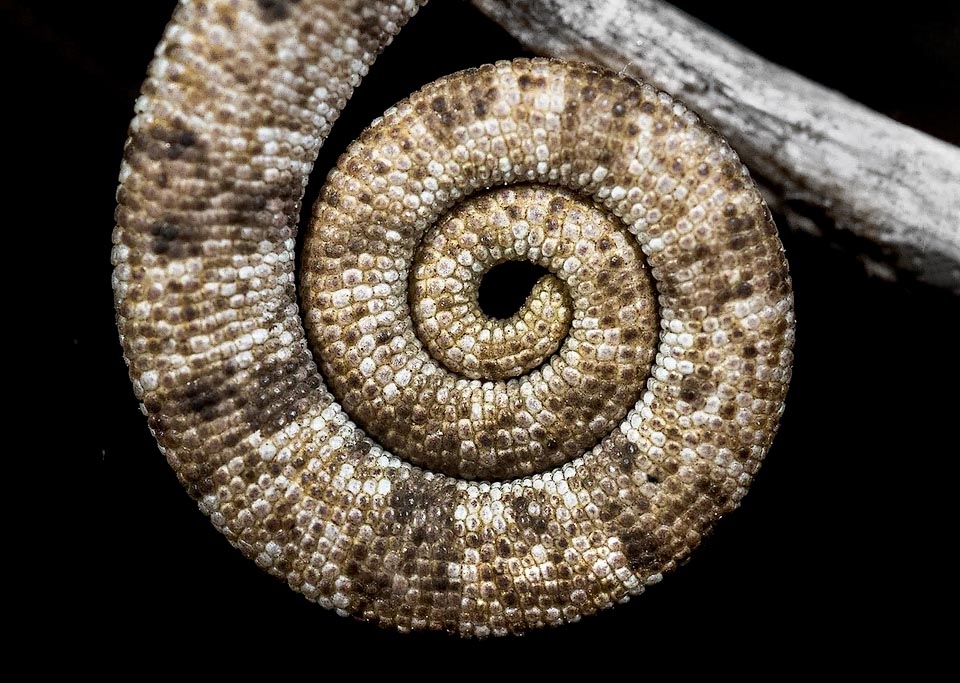
This, more or less rolled depending on the needs, serves to attach firmly or to dangle when moving among the branches © Rafi Amar
Ecology-Habitat
Chamaeleo chamaeleon is found from the sea level up to 1850 m of altitude in rather different environments, often in coastal pine forests characterized by the presence of Pinus pinaster, Pinus pinea, Pinus brutia, with shrubs of Nerium oleander and of the genera Juniperus, Retama and Genista, on the low dune vegetation with the genera Artemisia, Lygos, Zygophyllum, in vineyards, banana plantations, gardens and even in mountain areas with Pinus nigra, or semi-desert areas.
Predominantly diurnal and arboreal species, sometimes comes down to the ground for changing of shrub or for looking for prey; it is also able to swim to overcome a water obstacle.
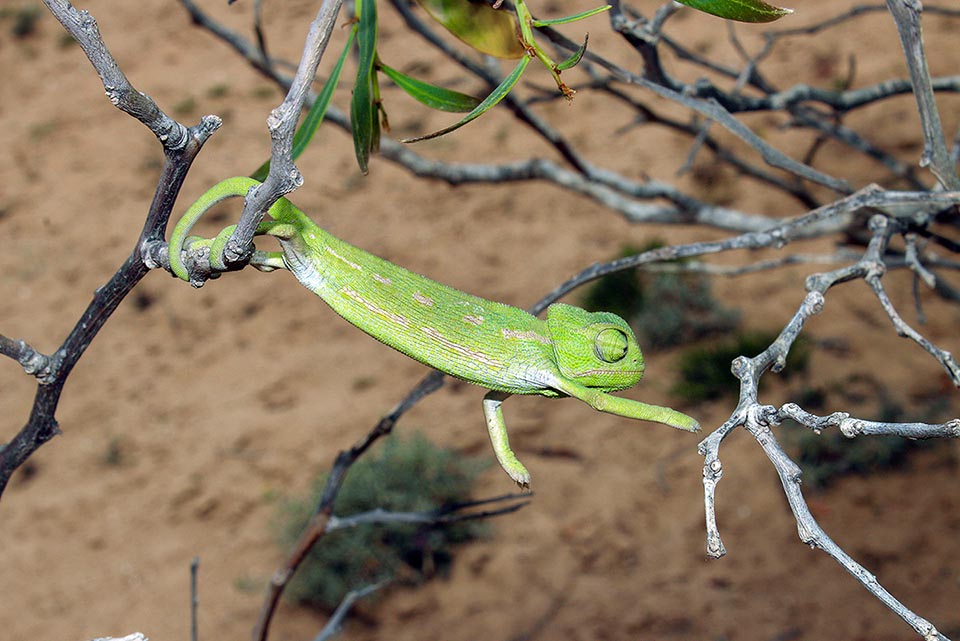
It’s the case of this juvenile passing from branch to branch while acrobatically descends to the ground © Karim Chouchane
Observations done on the subspecies Chamaeleo chamaeleon musae indicate that the juveniles rest mainly on the low vegetation, whilst the adults favour the tallest shrubs; conversely, the adults of the subspecies present in Cyprus stop in the low or high peripheral portions, avoiding the central parts, of the trees.
The Common chameleon is an insectivorous reptile, and the type of prey varies depending on the environment and on the location: in the Iberian peninsula and in Malta the orthopterans and the dipterans do prevail; in Libya it seems to mainly consume hymenopterans.
At times it also nourishes of juveniles of its own species and fruits.
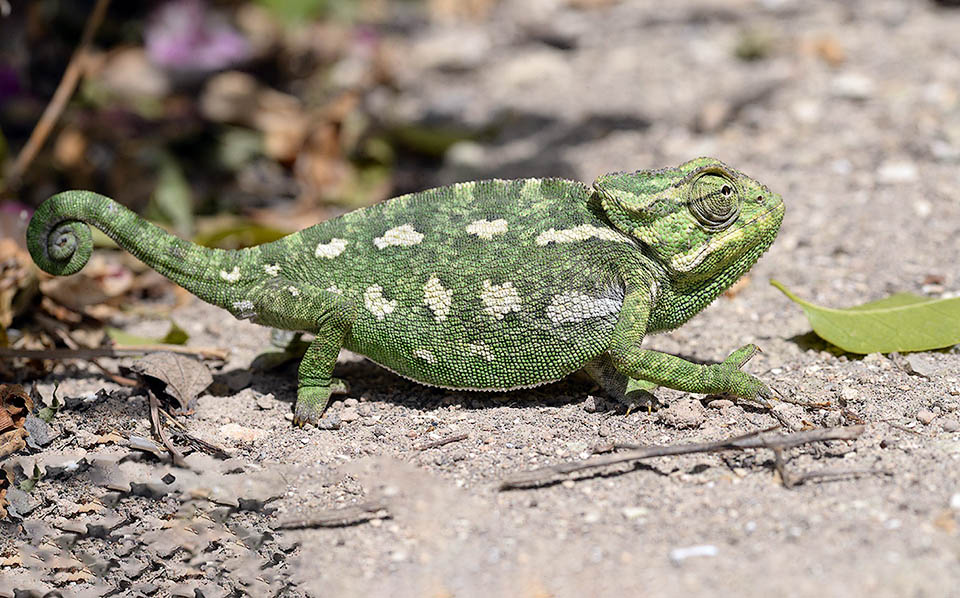
On ground the tail is of no use and is kept rolled while the animal moves with slow and rhythmic movements looking for insects. It seizes them hitting them like an arrow with its sticky tongue even one and a half as long times as the body It mainly eats orthoptera, diptera and hymenoptera,but also fruits and juveniles of its own species © Will Atkins
Snakes like Dolichophis jugularis, Malpolon monspessulanus or Spalerosophis diadema are habitual predators of the Common chameleon. Also the hunting strategies depend in part on the surrounding habitat: in environments having an abundant medium-high vegetation it assumes a sit-and-wait strategy waiting for the biggest prey, whilst in desert areas it fairly prefers an active hunting, moving with slow and rhythmic movements on grounds having low and scarce vegetation feeding on many small preys.
The annual activity period generally extends from March to November, and the hibernation occurs in any available cavity, even under stones and rocks, but if the outer temperature is favourable it may keep active even all over the year.
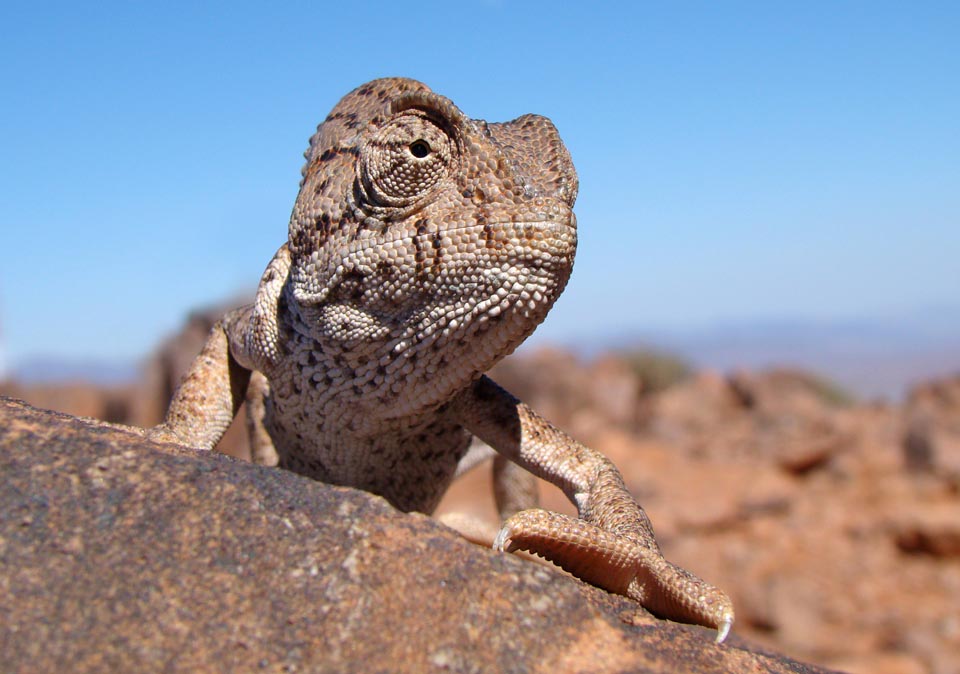
In desert or semi desert environments Chamaeleo chamaeleon assumes a pale brownish colour © Alberto Estefanía Hurtado
Morphophysiology
Chamaeleo chamaeleon is a reptile with a very laterally compressed body, weighing 15-40 g, long on average 190-250 mm of which approximately half is made up of the tail, bu may reach even 300 mm, with a vertebral crest formed by enlarged scales, and displays all those morphological, physiological and ethological peculiarities that characterize the family Chamaeleonidae and that render it a group of vertebrates standing among the most specialized.
Fist of all, the Common chameleon is zygodactylous ( from the Greek ζυγόν – zigón = tie, and δάκτυλος – dáctilos = finger) a term usually utilized for some climbing birds such as the parrots, and that indicates the fusion of the two outer fingers placed forward and the three inner ones back in the front legs, contrary to what happens in the back ones.
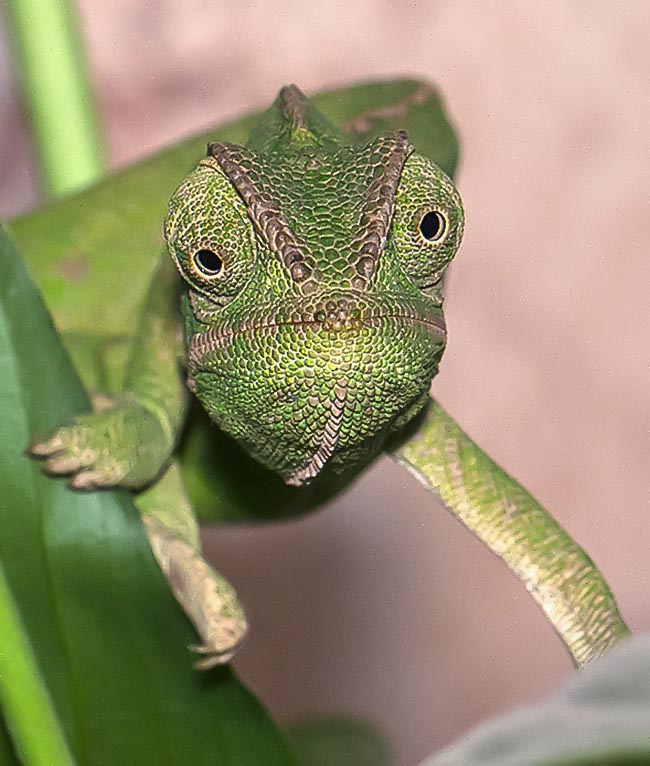
Unable to perceive sounds well, it has very big, bulbous towering eyes, able to move independently of each other, able to well elaborate at the same time two different images caught independently by the two eyes © Rafi Amar
This characteristic, united with the ability to rotate hands and feet and with the presence of sharp claws, ensures the chameleon a sure hold on any type of branch or trunk of tree.
Finally, to complete the perfect adaptation to the arboreal life, the long tail, remarkably prehensile, longer in the males, gives its contribution.
Unable to perceive sounds well, Chamaeleo chamaeleon makes up for this shortcoming with an exceptional vision being equipped with very big, bulbous towering eyes, able to move independently one of each other, with a 360° viewing range without the need to rotate the head, and able to elaborate simultaneously two different images independently catched by the two eyes.
Reptile dependent exclusively on its eyesight to hunt the preys, the Common chameleon analyzes the environment using the monocular vision with large regular movements, of about 180° horizontally and 90° vertically.
Once identified the prey even from great distances, the eyes converge to measure its precise distance by means of its binocular vision.
This is followed by the protrusion of the very long tongue, even one and a half times the length of the body, and its extremely rapid projection towards the prey that is thus caught.
The term “chameleon” is universally associated with the chromatic variations, regulated by the hormonal system as well as by the nervous ones, and essentially dependent on three layers of specialized cells, the chromatophores, located under the outer layer of skin that appears transparent.
The first layer contains yellow and red pigments, the intermediate one reflects the blue part for the light spectrum, whilst the innermost layer, brown and black, is mainly made up of melanin.
These layers are able to interact and to cause even very fast chromatic variations.
In the species having reduced motor abilities, for instance, unable to move quickly, the cryptism, that is the capacity to blend in with the environment, appears to be the most important strategy to avoid predators’ attacks.
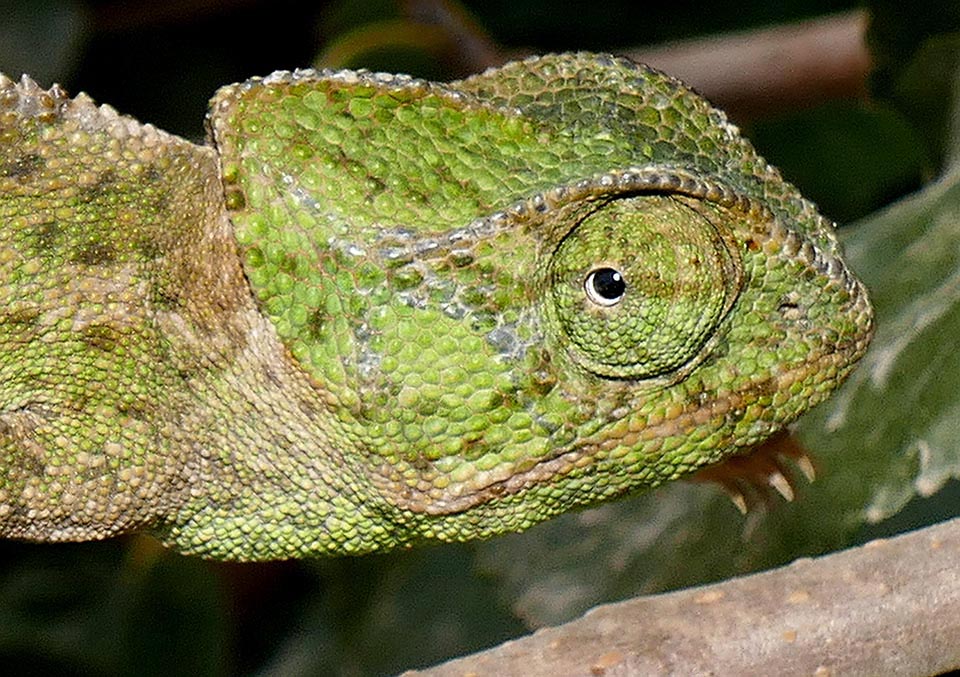
This Chamaeleo chamaeleon recticrista of Cyprus moves with its zygodactylous paw meanwhile its eye looks backwards. Without turning its head has a 360° visual range © Luca Tringali
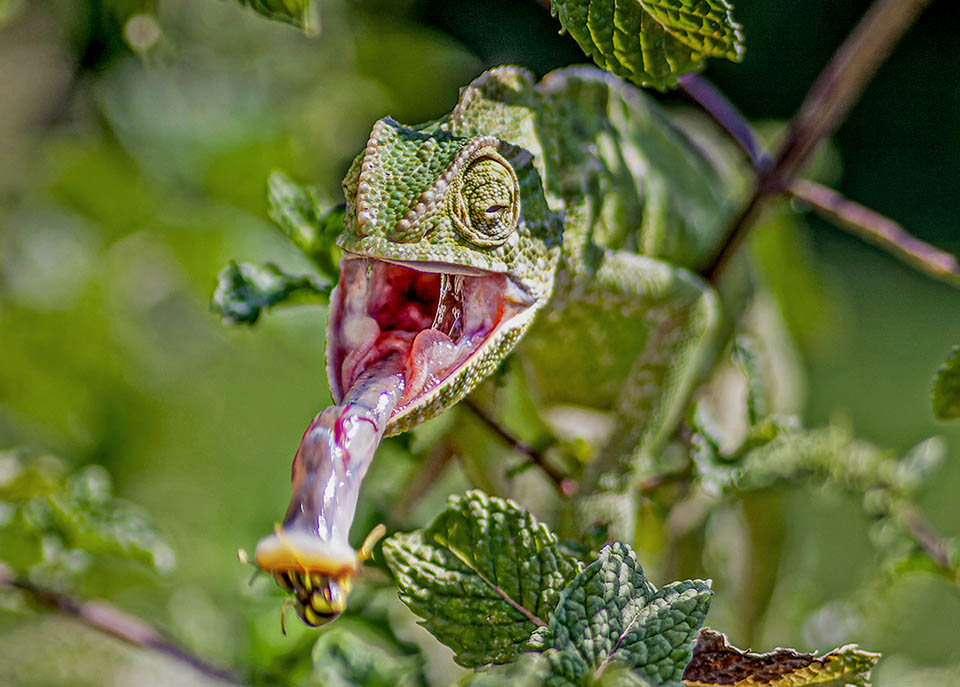
Prey identified, the eyes converge measuring the precise distance with the binocular vision. Here, with the fast tongue protrusion, has just seized a wasp © Stephen Daly
Like other reptilians, the Chamaeleo chamaeleon is able to camouflage itself assuming colours similar to those of the environment: its look gets usually “green” in presence of vegetation with leaves of the same colour, and “brown” in desert areas or on dead trees.
Actually, contrary to popular belief, these lizards do not modify their colour only with cryptic purposes, but also depending on their physical and physiological condition: a threatened individual can become very dark, almost black, and same thing occurs to the young individuals when in presence of adults, whilst a calmer chameleon gets a fairly clear colouration.
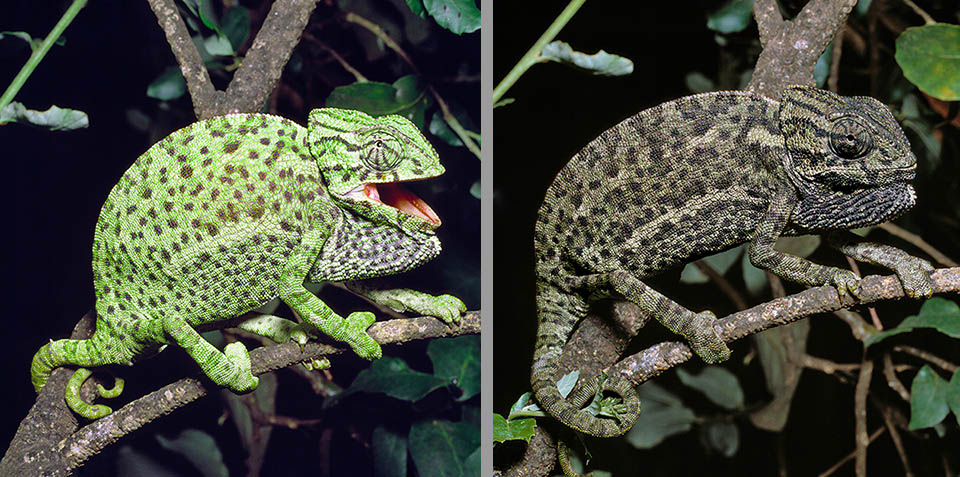
Contrary to belief, the chameleons do not change only for camouflaging, but also depending on their physical, physiological and emotional condition. For instance, the specimen on the left, feeling threatened opens mouth to scare the inopportune, but if this does not give up and is afraid quickly becomes almost black © Giuseppe Mazza
The chromatic variations contribute in regularizing the body temperature as the darker colourations, used with cooler climate, absorb all available solar radiation, whilst the paler ones, that reflect the light, help in cooling up the reptile.
Moreover, the chromatic changes are utilized also in the communication between sexes: the males, while courting present the brighter colouration they have at their disposal, whilst the females utilize the chromatic changes to show their level of availability, adopting a lighter colour to indicate a positive answer for the mating.
To increase the level of crypticism with the environment contributes, moreover, the body flattened laterally, almost leaf-shaped, that the Common chameleon moves synchronizing it with the leaves and the branches moved by the wind.
Ethology-Reproductive Biology
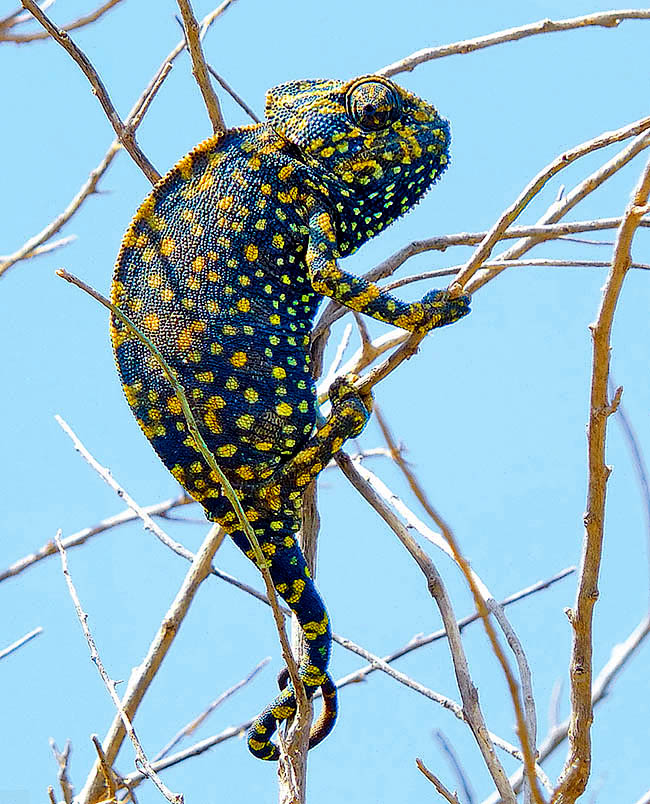
Characteristic liveries are then typical of reproductive period. The fecundated females in fact colour dark blue with elegant yellow spots, to indicate the males their status and the consequent unavailability to mating © Nick Dobbs
Chamaeleo chamaeleon is an oviparous reptilian that presents a summer courting, autumn oviposition and a prolonged incubation period, characteristics that differentiate the chameleons from the general reproductive model of the Mediterranean reptiles.
During the reproductive period, that extends from July to October, the males get very aggressive towards their rivals especially while courting.
To chase away the opponent they adopt various dissuasive behaviours, utilized also towards the predators: they flatten the body laterally to appear bigger, they move rhythmically, they open wide their jaws, swell the throat and emit a characteristic sound, until it inflicts strong bites; while mating the females are immobilized by means of a bloodless bite on the back and, if fecundated, they assume a typical dark blue colour sprinkled with yellow spots, a colour that indicates to the males their condition and the consequent unavailability for mating.
Between September and October the females dig long and deep tunnels for laying a single annual brood formed by 5-46 eggs, an activity that requires several hours and a remarkable energy waste.
In drought conditions, the effort required for the construction of the nest reflects in the smaller size of the brood, and some females don’t survive the fatigue: their mortality is higher in hotter and drier years.
The eggs hatch after about 260-370 days from the deposition, and the juveniles have a length of 50-75 mm; they reach their sexual maturity after one year and have a lifespan of 5-7 years.
Despite being classified “LC, Least Concern” in the IUCN Red List of the endangered species, Chamaeleo chamaeleon is a species locally threatened due to various factors: loss of the habitat, increase in the urbanization and of the tourist facilities, predation by domestic animals, unlawful export of wild animals or their utilization in the traditional medicines, car traffic. Especially the use in the traditional medicines and the car traffic form the main menace to the survival of this species.
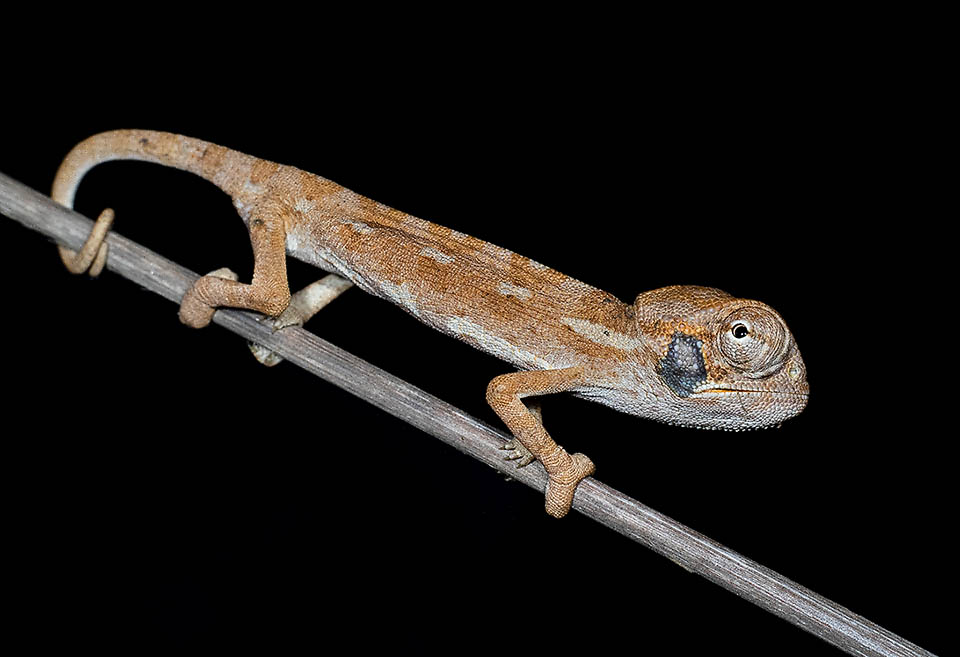
Chamaeleo chamaeleon is an oviparous species. Between September and October females dig long and deep tunnels for laying one only annual brood formed by 5-46 eggs. They hatch after about 260-370 days and juveniles measure 50-75 mm. They will reach their sexual maturity after one year and have a lifespan of 5-7 years © Rafi Amar
In the markets and in the so-called “Berber pharmacies” of north Africa many specimens are sold, often alive in order to keep their supposed thaumaturgical qualities intact, for preparing magic potions or healing remedies, however the greatest enemy of the Common chameleon appear to be represented by the car trafic: every year are killed on the roads hundreds of specimens, especially coinciding with the breeding period, when the males move looking for the females, or when the females are looking for the suitable sites where to dig the nests.
Synonyms
Lacerta chamaeleon Linnaeus, 1758; Chamaeleo parisiensium Laurenti, 1768; Chamaeleon vulgaris Daudin, 1802; Chamaeleo carinatus Merrem, 1820; Cameleo siculus Grohmann, 1832; Chamaeleo vulgaris Duméril & Bibron, 1836; Chamaeleon hispanicus Fitzinger, 1843; Chamaeleon rimulosus Gravenhorst 1843; Chamaeleo cinereus Strauch, 1862; Chamaeleon auratus Gray, 1865; Chamaeleon fasciatus Smith, 1866; Chamaeleo saharicus Müller, 1887.
→ To appreciate the biodiversity within the LIZARDS please click here.
